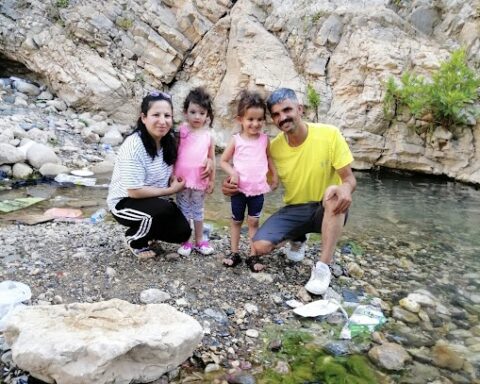In 2003, Canada opted out of the coalition that pummeled Iraq back into the Middle Ages. Now, Canada has joined the coalition to fight the Islamic State in Iraq and the Levant (ISIL) that emerged out of the U.S.-led invasion.
In this three-part series, Firas Al-Atraqchi, a member of NCM’s editorial board, frames the Iraq quagmire, traces the evolution of ISIL, and how the Islamic State has come to dominate large areas of Iraq and Syria. Before they elect a new government, Canadians need to weigh the pros and cons of taking the fight to ISIL.
Here are the current party positions —
Conservatives: Committed to bombing ISIL positions from the air in Iraq and Syria and deployment of troops in a non-combat role.
NDP: End bombing campaign and pull out all military personnel from Iraq and Syria; boost aid to help refugees affected by ISIL as well as investigate and prosecute war crimes.
Liberals: End the bombing campaign but keep military trainers in Iraq; boost aid to help refugees and allow more into the country from Iraq and Syria.
Greens: Ensure responses to terrorism are consistent with international law.
This is the second installment in a 3-part series. Read the first installment here.
While it is important to acknowledge that Islamic extremism did not exist in Iraq prior to the 2003 U.S. invasion, it is also equally vital to consider that ISIL was not born overnight but has evolved over the course of two decades.
With the Iraqi army disbanded by the U.S. administrators in Baghdad in 2003 and the borders now porous, it was easy for Jordanian Abu Musab Al Zarqawi to cross into the war-ravaged country and begin to establish a nexus of sectarian and extremist militias.
Naming his group Al-Qaeda in Iraq in homage to Osama bin Laden and Ayman Al Zawahri in Afghanistan, Al Zarqawi launched a brutal campaign of beheadings and deadly attacks against the Shia community.
Before Twitter, Facebook and YouTube came to be, Al Zarqawi’s people were already disseminating online videos of their executions.
Common lineage
Let’s trace the lineage a bit further. Bin Laden himself had been inspired by the Arab and Afghan Mujahideen who had succeeded in driving out Soviet forces from Afghanistan in the 1990’s.
The Mujahideen themselves had been inspired by the strategies and violent revolution called by Islamic Jihad and the Muslim Brotherhood in Egypt in the 1940’s-1980’s period. Zawahri was himself a former senior member of Islamic Jihad in Egypt in the late 1960’s and 1970’s.
Between 2003 and and his death at the hands of U.S. forces in 2006, Al-Zarqawi used the security vacuum and the political divisiveness that was forming between the Shia-led Iraqi government and the thousands of disgruntled Sunni generals and officers, politicians, and technocrats to recruit personnel.
His stated enemy was first and foremost the Shia community, whom he considered apostates. But he also targeted former senior cadres loyal to Saddam Hussein. The bottom line was that anyone who disagreed with Al-Qaeda in Iraq was put to the sword or assassinated.
Islamic militancy 2.0
He had also distanced himself from Al-Qaeda, which found his actions abhorrent. This is important to consider because Islamic militancy 2.0 now bears little resemblance to Al-Qaeda.
By the time he was killed in a U.S. air strike, he had laid the groundwork for the civil war which erupted between Shia and Sunni militias.
Tens of thousands were tortured and killed on both sides and Iraq looked like it was about to be torn apart at the seams.
In 2007, the U.S. Bush administration, which was still effectively running Iraq, decided to recruit Sunni tribal fighters (also including former Iraqi officers) to fight Al-Qaeda.
The Pentagon also dispatched additional American military units — a redeployment referred to as the “surge” — to assist these Sunni militias, known as Sahwa (awakening) brigades.
The strategy worked, somewhat. Al-Qaeda in Iraq was driven out of Anbar province, bordering Baghdad; the threat to the capital was removed.
Sowing discord
But this is where the first problem occurs. The media reported that Al-Qaeda was defeated. It wasn’t. It merely moved to another predominantly Sunni province, Nineveh, and began to slowly plan a resurgence.
In the years to come, the U.S. withdrew its additional forces and began to negotiate with Baghdad the Status of Forces Agreement (SoFA) to bring the entire deployment home.
While this was happening, the Sunni Sahwa fighters were growing increasingly disillusioned with Prime Minister Maliki (who replaced Jaafary in 2006). He failed to deliver on his promises to integrate them into the Iraqi military and repeatedly balked at regularly paying them monthly wages — a condition agreed to with the U.S. forces.
Instead, many of them were disarmed and arrested. They were now virtually defenceless against Al-Qaeda retaliatory attacks.
Simultaneously, significant political landmines, which threatened to further disenfranchise Sunnis from the political process, were coming to the fore.
Iraq was preparing for general elections in 2010, but the democratic process almost came unhinged as all of Iraq’s different political factions squabbled over a new electoral law.
Sectarian politics
It didn’t help either that hundreds of mostly Sunni candidates, many of whom were part of the Iraqiya bloc led by Shia secularist politician Iyad Allawi, were disqualified in a pre-poll purge.
Nevertheless, Iraqiya beat Maliki’s State of Law party. The UN lauded the elections as fair and free; the election process — bedeviled as it was — was seen as the Middle East’s most powerful statement of democratic institution building.
But this was not to last. Maliki challenged the results in a constitutional court by arguing a different definition of “bloc”. Eventually, he — not Allawi — was tasked with forming a new government.
The squabbles resurfaced, violence began to surge, and more Iraqis were being killed in terrorist attacks.
It took nine months for a government to be formed, but by then Al-Qaeda in Iraq had started to spread its tentacles back into Anbar from Nineveh, and re-branded itself as the Islamic State in Iraq (ISI).
Then history delivered a boon to the Islamic State.
Firas Al-Atraqchi is a Canadian journalist of Arab descent who has covered the Middle East since 1992. A former senior editor with Al Jazeera’s English-language website, currently he teaches journalism at the American University of Cairo as an associate professor.
Journalism & Communication Dept Chair; Managing Co-Editor @ Cairo Review of Global Affairs, American University in Cairo





